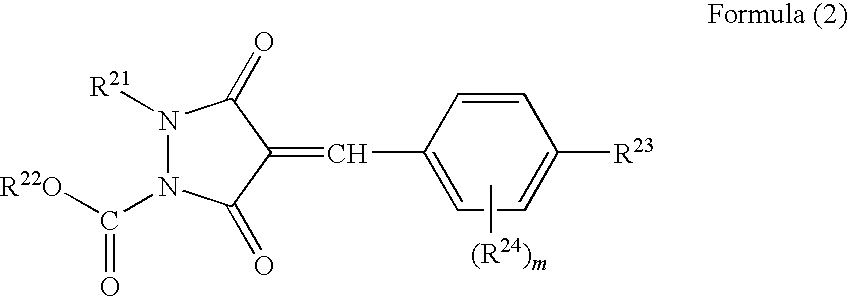Ultraviolet absorbent and polymer material containing the same
a technology of absorbent and absorbent, applied in the field of ultraviolet absorbent and polymer material containing the same, can solve the problems of reduced absorption capacity, inferior light stability, and limited free selection of compounds
- Summary
- Abstract
- Description
- Claims
- Application Information
AI Technical Summary
Benefits of technology
Problems solved by technology
Method used
Image
Examples
synthesis example 1
(Synthesis of Exemplified Compound 2)
[0215]1,2-Diphenylpyrazolidine-3,5-dion in amount of 0.8 g (3.2 mmol) and p-tolualdehyde in amount of 1.0 g (8.3 mmol) were agitated at 100° C. for 30 minutes under the condition of nitrogen flow to prepare a reaction mixture, and then the reaction mixture was cooled to room temperature. Thereafter, 10 ml of ethanol was added to the reaction mixture. The above-specified product was obtained as a yellow solid by a recrystallization treatment (yield: 0.94 g, 83%).
[0216]The absorption maximum wavelength of the exemplified compound 2 in ethyl acetate solution was 345 nm, indicating that the compound had long-wavelength ultraviolet absorption capacity.
[0217]1H NMR (CDCl3): δ 2.45 (3H), 7.15 (2H), 7.3-7.4 (6H), 7.45 (4H), 8.1 (1H), 8.45 ppm (2H)
[0218]FAB MS (Matrix: 3-Nitrobenzyl Alcohol) m / z 355 ([M+H]+), 354([M]+, 100%)
synthesis example 2
(Synthesis of Exemplified Compound 22)
[0219]2-Ethoxycarbonyl-1-phenylpyrazolidine-3,5-dion in amount of 0.8 g (3.2 mmol) and p-anisaldehyde in amount of 1.0 g (8.3 mmol) were agitated at 100° C. for 30 minutes under the condition of nitrogen flow to prepare a reaction mixture, and then the reaction mixture was cooled to room temperature. Thereafter, 10 ml of ethanol was added to the reaction mixture. The above-specified product was obtained as a yellow solid by a recrystallization treatment (yield: 1.08 g, 92%).
[0220]The absorption maximum wavelength of the exemplified compound 22 in ethyl acetate solution was 378 nm, indicating that the compound had long-wavelength ultraviolet absorption capacity.
[0221]1H NMR (CDCl3): δ 1.25 (3H), 3.95 (3H), 4.3 (2H), 7.0 (2H), 7.2-7.5 (5H), 8.1 (1H), 8.6 (2H)
[0222]FAB MS (Matrix: 3-Nitrobenzyl Alcohol) m / z 367([M+H]+), 366([M]+, 100%)
[0223]Further, other exemplified compounds can be synthesized by referring to the above-described synthetic methods...
example 1
[0224](Preparation of molded plates (Sample Nos. 101 to 118))
[0225]One (1) kg of a polymethyl methacrylate resin (PMMA) (Tg: 100 to 110° C.) and 0.1 g of the exemplified compound 1 were agitated in a stainless steel tumbler for 1 hour. The mixture was melted and blended by a vent extruder at 230° C. and extruded into pellets for molding by an ordinary method. The pellets were dried at 80° C. for 3 hours, and then, molded into a molded plate having a thickness of 3 mm (Sample No. 101) by an injection molding machine.
[0226]Molded plates of the exemplified compounds 2, 3, 4, 5, 6, 7, 8, 10, 11, 12, 14, 22, 23, 24, 25, 29 and 32 (Sample Nos. 102 to 118) were prepared similarly, except that the exemplified compound 1 was replaced with the exemplified compound 2, 3, 4, 5, 6, 7, 8, 10, 11, 12, 14, 22, 23, 24, 25, 29 or 32.
[0227]The absorption maximum wavelength λmax values of the exemplified compounds 1, 2, 3, 4, 5, 6, 7, 8, 10, 11, 12, 14, 22, 23, 24, 25, 29 and 32 in ethyl acetate soluti...
PUM
| Property | Measurement | Unit |
|---|---|---|
| Temperature | aaaaa | aaaaa |
| Percent by mass | aaaaa | aaaaa |
| Percent by mass | aaaaa | aaaaa |
Abstract
Description
Claims
Application Information
 Login to View More
Login to View More - R&D
- Intellectual Property
- Life Sciences
- Materials
- Tech Scout
- Unparalleled Data Quality
- Higher Quality Content
- 60% Fewer Hallucinations
Browse by: Latest US Patents, China's latest patents, Technical Efficacy Thesaurus, Application Domain, Technology Topic, Popular Technical Reports.
© 2025 PatSnap. All rights reserved.Legal|Privacy policy|Modern Slavery Act Transparency Statement|Sitemap|About US| Contact US: help@patsnap.com



